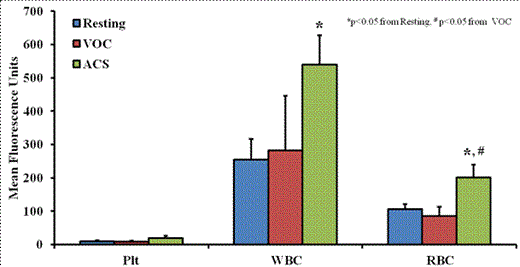Abstract
Microparticles (MP) are small (less than 1 µm), membrane-derived extracellular vesicles produced following cellular activation or apoptosis. They have been implicated as causative in a wide variety of pro-inflammatory diseases. Sickle cell disease is a hemoglobinopathy characterized by chronic hemolysis and systemic inflammation which can be complicated by vaso-occlusive pain crises (VOC) or the acute chest syndrome (ACS). Increasingly there is evidence that microparticles may play an important role in the pathophysiology of sickle cell disease. We hypothesize that plasma microparticles are elevated during ACS compared to VOC and baseline (resting).
Whole blood was obtained under an approved consent from the Colorado Multiple Institution Review Board at the University of Colorado Denver, from three subjects with homozygous sickle cell disease (ages 4-18) at three distinct time points: baseline (resting) at routine clinic visits and upon hospitalization for VOC and ACS. The samples underwent differential centrifugation: plasma was isolated (5,000xg for 7 min at RT) and then cell free supernatant was separated (12,500xg for 6 min at 4°C). MPs were isolated by centrifugation at 17,000xg for 60 minutes at 4°C, and the MP pellet was resuspended in an equal volume of 1.25% human serum albumin. The samples were incubated with CD41 (PE)-, CD45 (PerCP-Cy5)-, and CD235 (FITC)-antibodies that are specific for MPs derived from platelets, leukocytes, and erythrocytes, respectively, and analyzed by flow cytometry. Statistics were performed using ANOVA with post-hoc Newman-Keuls test.
The amount of leukocyte-derived MP (WBC) measured during ACS was significantly higher (almost two-fold) than levels measured during baseline (resting) (p < 0.05), but not VOC. The erythrocyte (RBC) MP levels were also significantly elevated during ACS, compared to resting and VOC (p<0.05). There is a trend toward higher platelet (Plt) MP levels during ACS compared to both baseline and VOC, however this does not reach statistical significance likely due to the small sample size (n=3) (Fig. 1). In a separate analysis, the MPs from two patients admitted for VOC with evolution to ACS during the same hospitalization exhibited a three-fold increase in WBC MP levels during VOC that preceded their progression to ACS by 24-72 hours.
Microparticles may play a significant role in the pathophysiology of ACS in sickle cell disease. Leukocyte-derived MPs are elevated in ACS at higher levels than baseline. This likely reflects the important role of white blood cells (WBCs) in systemic inflammation and the importance of WBC-endothelial interactions in ACS. While platelet- and erythrocyte-derived MPs may be involved in ACS, a larger sample size will be needed to detect this effect. In addition, while hospitalized, two patients who had a similar magnitude increase in WBC MPs during VOC eventually progressed to ACS; thus, serial MP measurements could potentially serve as a biomarker to identify patients at risk for imminent development of ACS. Further prospective studies with larger sample sizes will be needed for validation. Future directions of study should also evaluate the role of endothelial-derived MPs and the role of ICAM-1.
No relevant conflicts of interest to declare.
Author notes
Asterisk with author names denotes non-ASH members.


This feature is available to Subscribers Only
Sign In or Create an Account Close Modal